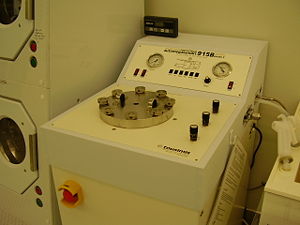Specific Process Knowledge/Wafer and sample drying/Critical Point Dryer
Unless anything else is stated, everything on this page, text and pictures are made by DTU Nanolab.
All links to Kemibrug (SDS) and Labmanager Including APV and QC requires login.
Feedback to this page: click here
Critical Point Dryer
The critical point dryer is used to dry fragile structures that may be damaged in a normal drying procedure. Fragile structures can be thin membranes, or free hanging structures like cantilevers and grippers.
The user manual(s), technical information and contact information can be found in LabManager:
Critical Point Dryer in LabManager
In the critical point dryer, samples are dried in supercritical CO. In the drying process, the sample is first put into Isopropanol for at least 1 hour, and then loaded into the machine. When the machine is started, the isopropanol is exchanged for liquid CO. When there is only CO in the machine, the pressure and temperature in the chamber is raised, above the so called “critical point”. At this point, there is no longer a liquid/gas interfacen, but instead the CO is in a supercritical state. Because of this, the problem with surface tension, which destroys the fragile structures through capillary forces, is avoided.
| Purpose | Drying of wafers or chips |
To dry fragile structures (example membranes, grippers, cantilevers). |
|---|---|---|
| Process parameter range | Process Temperature | 0 oC to 45 oC |
| Process pressure |
1 atm to (maximum) 95 atm (1400 PSI) | |
| Substrates | Batch size |
|
| Materials allowed |
|

